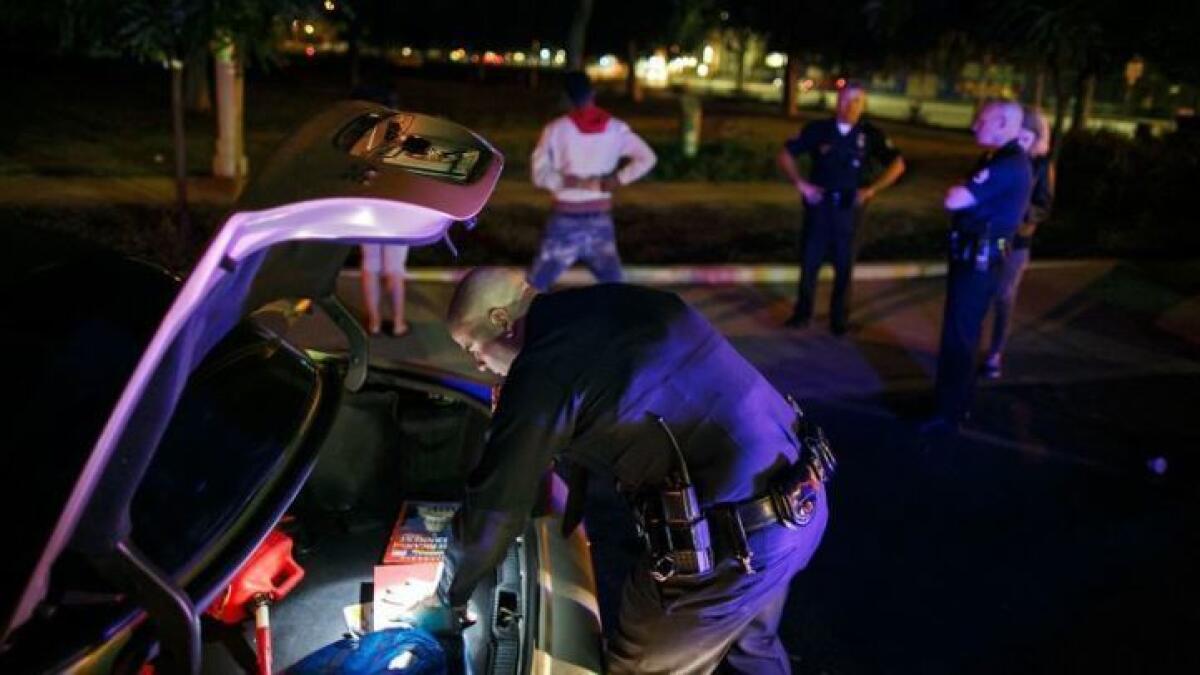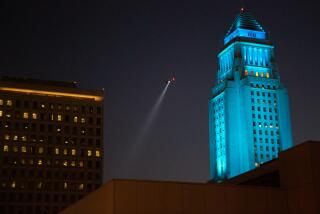L.A. Mayor Garcetti calls for audit of elite LAPD unit over stops of black drivers

Mayor Eric Garcetti on Monday called for an audit of stops by the Los Angeles Police Department’s elite Metropolitan Division in response to a Times investigation showing the unit pulled over black drivers at disproportionately high rates.
Garcetti said the report, which found that Metro officers stop black drivers at a rate more than five times their share of the population, is “something that troubles me and is deeply concerning.”
For the record:
7:00 p.m. Jan. 29, 2019An earlier version of this article misstated the subject and timing of an LAPD inspector general audit. The audit is of the LAPD’s Gang Enforcement Detail, not the Gang and Narcotics Division. It is expected to be released on Feb. 1, not this month.
“Trust is essential to our public safety, and every Angeleno deserves to be offered dignity and respect,” Garcetti said at a news conference Monday morning on 2018 crime statistics.
According to the Times analysis, nearly half the drivers stopped by Metro are black, in a city that is 9% black, which has helped drive up the share of blacks stopped by the LAPD overall from 21% to 28% since the Metro expansion.
Police Chief Michel Moore said Monday that the Times’ analysis “renews an important question” on how law enforcement strategies affect public trust and the safety of those who live in neighborhoods affected by violent crime.
“I look forward to a more expansive conversation on the topic,” Moore said. “Critically important is that the communities of South Los Angeles, and particularly the African American community, have confidence that this department’s efforts are genuine and intended to save lives.”
The move comes as some civil rights activists have demanded a deeper examination of how the Metro division patrols and whether the tactics amounted to racial profiling.
The LAPD’s Office of Inspector General had already been working on an audit of Metro traffic stops, but Garcetti’s directive gives the project added urgency.
Moore credited the expansion of Metro in 2015, which deployed crime-suppression platoons to high-crime areas, with helping to reduce violent crime.
In 2018, homicides were down 8% from the previous year, and gang-related crime was down 8%. Violent crime was down for the first time in five years.
Metro makes most of its vehicle stops in South Los Angeles, which is almost one-third African American. But even there, the percentage of black drivers stopped by Metro is twice their share of the population, the analysis found.
Since Metro doubled in size to about 400 officers as part of an effort to stem a surge in violent crime, the number of vehicle stops performed by the division has skyrocketed from a few thousand to nearly 60,000 in 2018.
Unlike regular patrol officers, Metro officers often spend their entire shifts on vehicle stops and other “proactive” policing tactics intended to root out violent criminals.
They typically use a violation such as a broken taillight as a starting point to question the driver and potentially get inside the car — a type of stop known as a pretextual stop.
More than 90% of the drivers stopped by Metro citywide since the expansion have been black or Latino.
Latinos are slightly underrepresented in Metro stops, making up 49% of the population and 44% of stops. Whites, who make up 28% of the city’s population, account for less than 4% of the drivers stopped by Metro, according to the analysis.
Metro stops black drivers 13 times more often than white drivers.
The data analyzed by The Times do not show why an officer pulled over a driver. Nor can the data prove that Metro officers are engaged in racial profiling.
But civil rights advocates say the racial breakdowns are too skewed to be fully explained by factors other than profiling.
In addition to the audit of Metro stops, the inspector general’s office is working on an audit of stops by the LAPD’s Gang Enforcement Detail, using videos from body-worn and in-car cameras.
The gang division audit is expected to be released on Feb. 1, while the audit on Metro stops will come out late this year or early next year.
In July, the LAPD resumed collecting data on what happens to drivers after they are stopped, as required by a new state law. Under a federal consent decree, the department had been required to record information such as whether drivers were searched or arrested but halted the practice after the decree was lifted in 2013.
Post-stop data can illuminate racial disparities and shed light on the effectiveness of the stops.
At the news conference, Garcetti and Moore touted last year’s crime declines as evidence that LAPD strategies are working.
Hundreds of officers have been reassigned from desk jobs or specialized units — including Metro — to street patrol or station-based detective work. The city has expanded its signature gang intervention program, GRYD, where reformed gang members mentor young people and try to prevent retaliatory shootings.
This year, the LAPD will extend a community policing program that began in Watts housing developments to two new locations: San Fernando Gardens in Pacoima and South Park in the downtown area.
Moore said the question of whether Metro should stop so many black drivers is “far more complex than the use of the simple comparison made in the L.A. Times report.”
In combating violent crime, the LAPD couples enforcement, such as the Metro crime suppression platoons, with community engagement, such as the gang intervention program, Moore said.
“We know the incidence of violent crime does not strictly follow the proportionality of the ethnic makeup of a community. Neither should our enforcement strategies,” he said.
In a blog post, the Los Angeles Police Protective League, which represents rank-and-file LAPD officers, lambasted the Times report for “cherry-picking data to align with a preconceived false narrative.”
The post, signed by the union’s board of directors, noted that in 2017, more than 36% of homicide victims in Los Angeles were black. That same year, 40% of homicide suspects were black, according to the LAPD.
“At the Mayor’s direction, the LAPD added more resources where there is more crime and more crime victims,” the board wrote. “That decision was not based on race, it was based on calls for service and the occurrence of crime.”
Civil rights activist Earl Ofari Hutchinson called on the LAPD to release information showing that the Metro vehicle stops have led to citations or arrests. He said the LAPD should suspend the practice until a thorough review is completed.
“They’ve got to show an end result,” Hutchinson said. “If they’re stopping so many people of a particular ethnic group and not making arrests tied into a crime they actually committed, what is it but profiling? Stopping them on suspicion they’re black, that they may commit a crime? That’s profiling.”
Garcetti said he understands the demand for answers.
“Angelenos deserve to understand the full picture when something outside the ordinary happens with any of our officers,” he said.
The mayor added that he spends a lot of time with Metro officers — his bodyguards come from the division — and admires their “courage and commitment.”
For more news on the Los Angeles Police Department, follow me on Twitter: @cindychangLA
More to Read
Start your day right
Sign up for Essential California for news, features and recommendations from the L.A. Times and beyond in your inbox six days a week.
You may occasionally receive promotional content from the Los Angeles Times.







